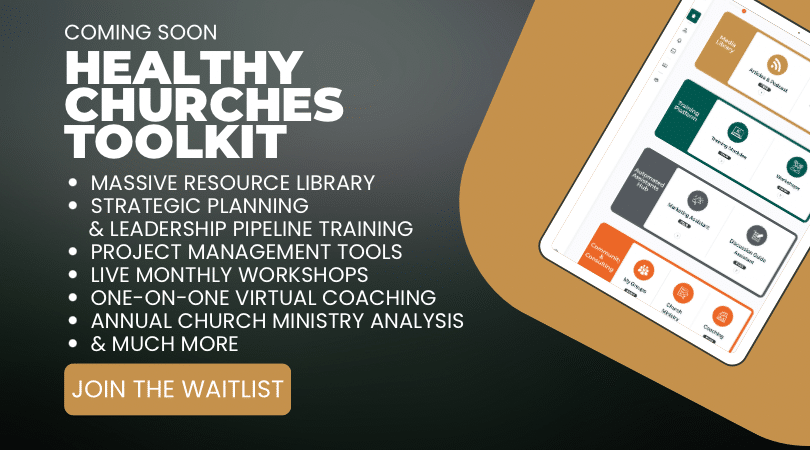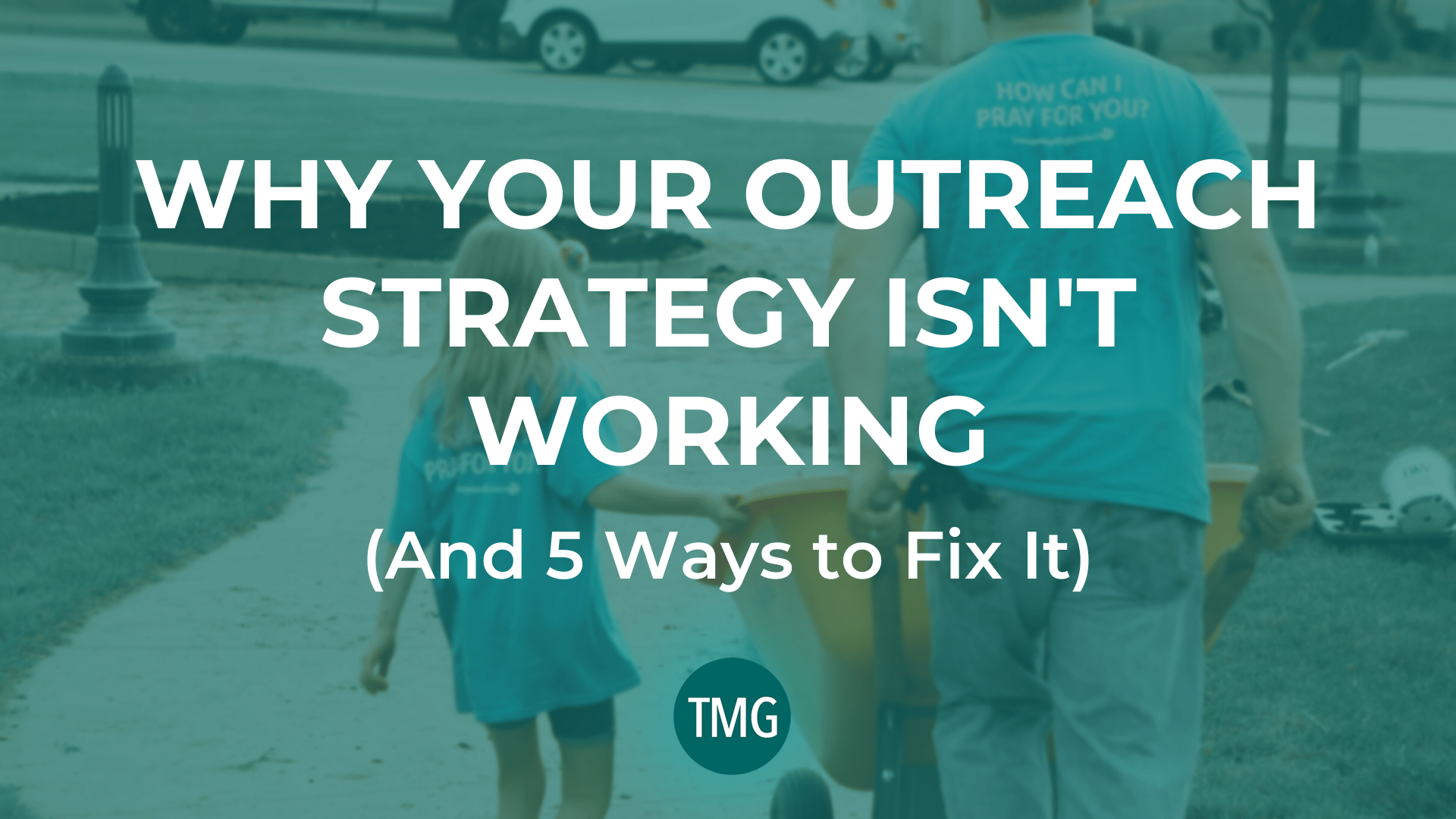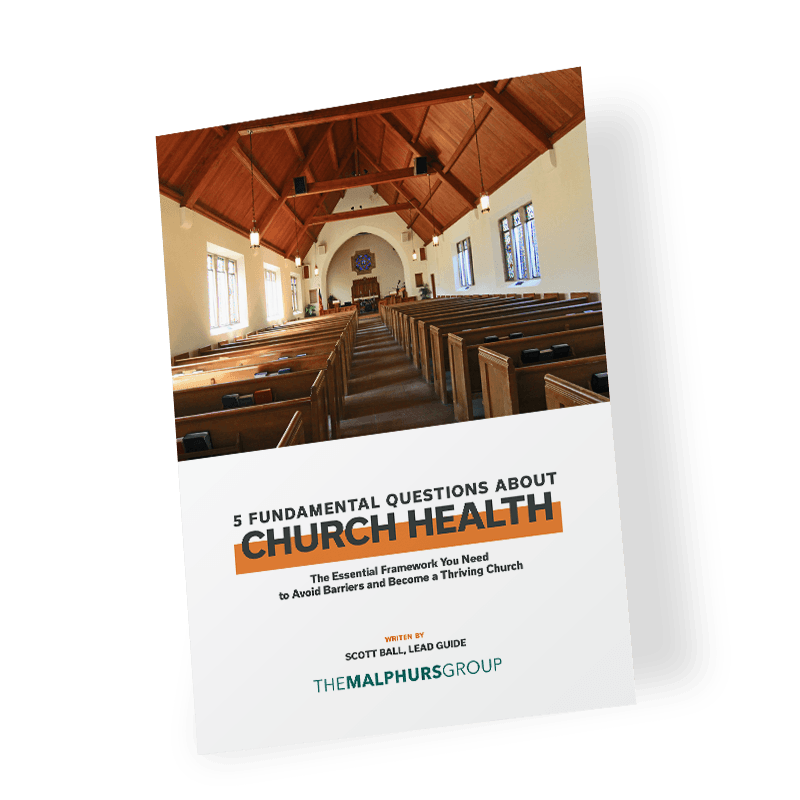Church Revitalization Podcast – Episode 102
Let’s be honest with each other. Your church outreach strategy probably isn’t working particularly well.
The vast majority of churches in the United States are in decline, and of those that are growing, only a fraction of them are reaching the unchurched. Most modern church growth is “sheep shuffling.”
Your church may have tried to update your worship services to attract newcomers, but the obvious problem goes unaddressed. People don’t know that your church exists. Better music doesn’t fix that.
Church leaders like to tinker with worship services because they’re operating under the false pretense that the Sunday Morning Machine is the driving force behind future growth. All the while, churches neglect their outreach strategy. As a result, your church becomes more irrelevant to the community–not because of your worship style but because you’re failing to engage the real problems of real people.
Traditionally, churches have outsourced evangelism to experts: missionaries and denominational or parachurch organizations. They give large sums of money to organizations, and may volunteer in local organizations that provide food assistance or shelter for the homeless–even if these are not the most widespread challenges facing the community. Many churches we’ve worked with will drive up to an hour away to volunteer in homeless shelters and soup kitchens, but ignore the challenges of the families that are right in their neighborhood.
The failure to create a winning church outreach strategy is usually rooted in the inability to conceive of anything different from what has already been done.
In the paragraphs below, we’ll explore how to build a winning outreach strategy, and how you can use five criteria to help you craft a custom strategy that works in your context.
Subscribe below to never miss an episode.
First, Know Your Community
Making a difference in your neighborhood is predicated on having an understanding of the challenges of your community. If you don’t know what the problems are, you cannot address them. You can gain a better understanding of your community by taking two key steps.
First, conduct a Community Needs Survey. Ask a few key questions about your community: what are the strengths? What are the weaknesses? What are the greatest challenges facing the community? What are the greatest opportunities for growth? You can create a simple, multiple choice survey and collect responses in a variety of ways. For example, you can get permission to collect surveys at a local grocery store or other business where people of all socioeconomic backgrounds would be found. You can run a digital version of your survey and solicit responses through a targeted social media campaign. You can ask your congregation to take the survey; it’s often illuminating to compare your church’s responses with those from the outside community. A Community Needs Survey provides an opportunity for your neighbors to tell you directly what problems they perceive.
Second, meet with local school counselors. Counselors, even more than principals or other administrators, have a front-row seat to the biggest challenges facing families in your community. If you ask, they will gladly share the struggles and needs. While they are unlikely to give you names or specifics, they can share the broader problems and are usually desperate for help. Many counselors buy shoes, clothes, and other items out of their own pockets to help kids. They will not turn down an offer for help.
By stepping out of your comfort zone and connecting with the community, you can discover the actual needs rather than the hypothetical or hackneyed needs of a homeless shelter or food pantry (as good as those things are).
The 5 D’s
In the book Boomerang: The Power of Effective Guest Follow-Up, Tyler Smith and Alison Hofmeyer describe something that they call the 5D Theory. They suggest that people are most likely to show up at a church as a result of one of these five D’s: Divorce, Death, Displacement, Disaster, or Development. These five D’s function as really helpful criteria for shaping a winning outreach strategy. While all five of these D’s play some part in your community, there may be one or two that are especially apparent. By leveraging your knowledge from your Community Needs Survey and applying the 5D lens, you can create a custom church Outreach strategy that is tailored to the needs of your community. Let’s explore each of the D’s and how it could impact your outreach strategy.
Divorce
Despite your assumptions, divorce rates are not ubiquitous. It’s true that divorce is more common generally than it was a few decades ago, it is not true that divorce rates are equally widespread. Simple psychographic research found on theARDA.com or from a service like Gloo can give you fairly accurate estimates of divorce rates and family challenges in your area.
If you find that divorce is common in your area, what can you do about it? How can you shape your outreach strategy to help prevent divorces? What are the root causes of divorce? Perhaps offering Financial Peace University can help eliminate money fights. Perhaps you could offer groups like Celebrate Recovery or other recovery groups that help fight substance and pornography addictions. How can you serve people who have already been through a divorce and find the healing they need in Christ? Hosting Divorce Care may be appropriate.
The key is not to merely offer a random assortment of classes and groups. Target the specific challenges that are causing divorce, and tailor your messaging to families in the community as a way to help them. For example, you could run an ad on Facebook that says, “Money fights killing date night? Sign up for Financial Peace University at First Community Church and save the joy of your next night out!” Now, the church isn’t just offering Financial Peace University because a church down the road did it once, the church is on a mission to save marriages from money problems and money fights.
Death
After the Covid-19 Pandemic, one glaring reality came to the forefront: we live in a culture that doesn’t know how to cope with death. Generations ago, people spoke about death and accepted it. In a humanistic culture that is increasingly unchurched and atheistic, the fear of death is at an all-time high. Look at the demographics of your community. Do you live in an area with many senior adults that are having to process the loss of loved ones? Was your area especially hard-hit by the pandemic, and there are lingering traumatic effects? What outreach opportunities exist to comfort people in their day of mourning?
Perhaps your church can host a professional counselor or counseling center. Maybe the church should offer a support group like GriefShare. Or, if you live in an area filled with agnostics and atheists, a program like Alpha may be successful. As more people have existential questions, the Alpha program welcomes skeptics and their questions.
While we rarely think of death as a church outreach opportunity, the church has largely failed to “mourn with those who mourn.” When Lazarus died, Jesus wept. Likewise, the church must step into these moments to offer both comfort and hope.
Displacement
The third D, displacement, speaks to people moving. If you live in an area of high turnover, this is something you should pay attention to. Are families moving into your area for jobs or new homes being built? When people move, they usually lack community.
Areas with lots of new residents are prime spots for hosting block parties and other community gatherings. If your building is in a neighborhood, host the event there. If your church isn’t near these homes, find hosts for neighborhood picnics. People are desperate for connection, and the church ought to be a great facilitator of community.
Displacement can also come as a result of immigration. Some rural communities have hundreds of migrant workers that come each year. These workers are often secluded and insular. What if your church engaged these communities rather than pretend they don’t exist? Your church could provide ESL classes or address other felt needs like food insecurity or clothing assistance.
Disaster
Disaster can carry a lot of connotations, and they all apply. Certainly, if your community experiences a natural or human-caused disaster like a tornado or school shooting, your church has an opportunity to stand in the gap and reach people. But most churches don’t need to be told this.
Instead, think of slow-rolling disasters–the ones that don’t make the news. In my area, the opioid epidemic is ravishing our community. Churches have an opportunity to care for addicts, their families, and for those who are in prison as a result of their addictions. It’s not an overstatement to say that churches could save lives if they took a proactive approach to dealing with the opioid epidemic. Other similar disasters are happening all across the country: high school dropout rates, unwed pregnancy, gang violence, and more. If there is a specific, acute problem in your community, you should focus on addressing that disaster. People in your neighborhood will accept the help, and you can make an undeniable impact.
Development
While the previous four D’s are more like challenges, the final D–development–is more opportunity-focused. People will engage with a church if they believe that the church can make their life appreciably better. Often, the church is seen as being able to help with marriages, kids, or family life. But through your community needs survey, you can discover what opportunities your church has to help people develop. For example, after-school programs can bridge the gap for stressed, overwhelmed parents. Other programs designed to improve quality of life in struggling communities can make an enormous difference.
But even in affluent, white-collar communities, the Development aspect of outreach is critical. In fact, churches in suburban neighborhoods that have “no problems” are the most likely to shrug their shoulders, and choose to drive 30 minutes to the homeless shelter instead. Unseen challenges like mental health and parenting problems are no less important than food insecurity or homelessness. If the pain is real to the person, it should be real to your church. Determine what the specific pain points are in your community, and meet people in them. Making these shifts will make a far greater impact than any change you make to your preaching or music.
It should go without saying, but a dynamic outreach strategy is no substitute for personal evangelism. In an ideal world, your church outreach strategy is merely a jumping off point for personal evangelism. Be sure that you supplement your church-wide outreach efforts with good training on how to share your faith. That way, as the Lord provides opportunities, people in your congregation will be able to “give the reason for the hope that you have,” (1 Peter 3:15).
Nevertheless, your church can drastically improve your outreach strategy by taking these words to heart. First, know your community. Understand the specific challenges and opportunities in your neighborhood. Use the eyes of a missionary to ensure that you see the needs as they actually are. Then, apply these 5 D’s to help you determine which areas you should focus on. You cannot do it all. Instead, choose which areas to channel your efforts. These shifts in your church outreach strategy will make a far greater impact than any change you make to your preaching or music.
BONUS: Get a free Team Discussion Guide in the video description on YouTube.


Scott Ball is the Vice President and a Lead Guide with The Malphurs Group. He lives in East Tennessee with his wife and two children. (Email Scott).

